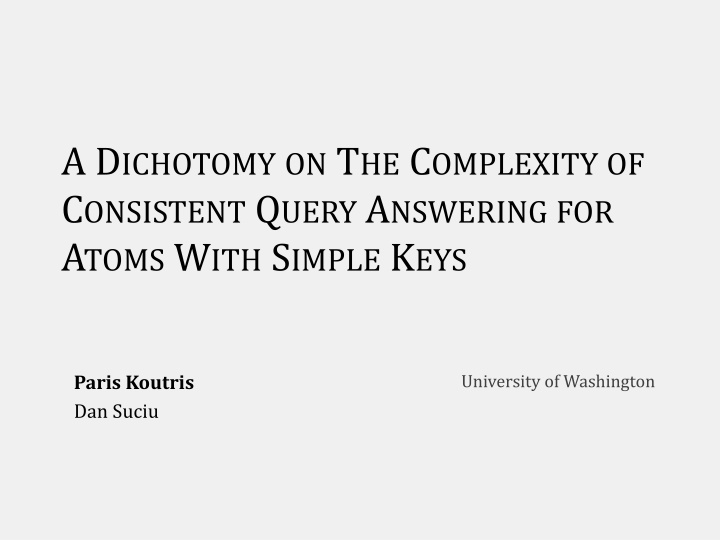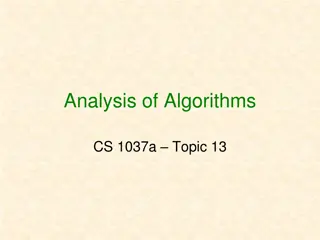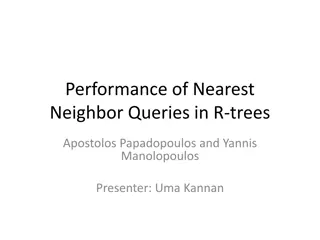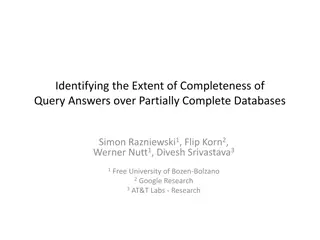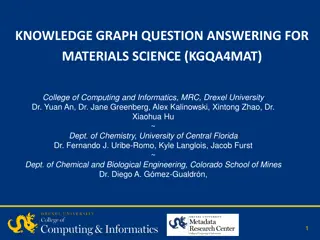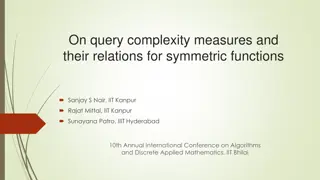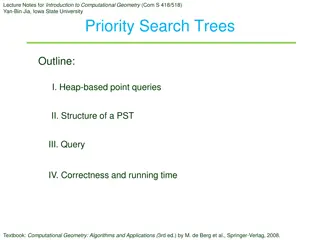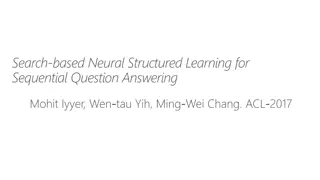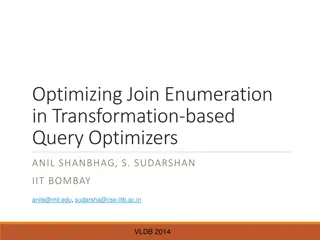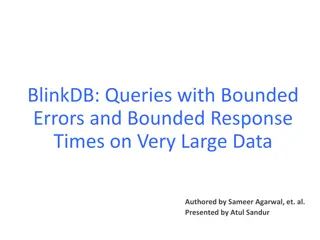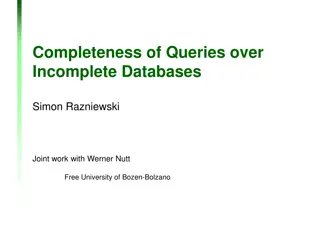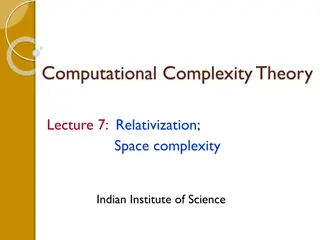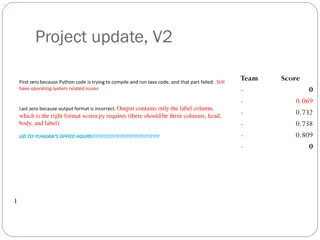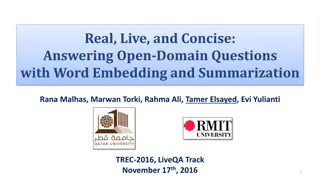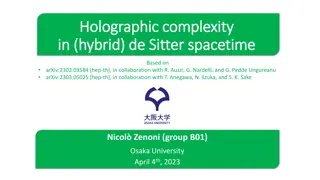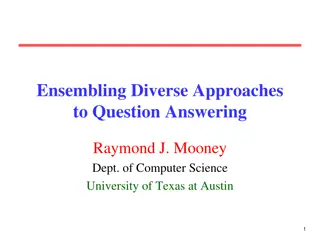Dichotomy on Complexity of Consistent Query Answering
The research paper presents a dichotomy on the complexity of consistent query answering for atoms with simple keys. It discusses repairs for uncertain instances in a schema with key constraints, as well as the concept of consistent query answering. The document addresses the problem statement of certainty, progress made in the field so far, and outlines the contributions towards understanding the certainty of boolean conjunctive queries. The study offers a theorem highlighting a dichotomy for queries without self-joins, where atoms have simple keys, leading to a classification into PTIME and coNP-complete categories.
Download Presentation

Please find below an Image/Link to download the presentation.
The content on the website is provided AS IS for your information and personal use only. It may not be sold, licensed, or shared on other websites without obtaining consent from the author.If you encounter any issues during the download, it is possible that the publisher has removed the file from their server.
You are allowed to download the files provided on this website for personal or commercial use, subject to the condition that they are used lawfully. All files are the property of their respective owners.
The content on the website is provided AS IS for your information and personal use only. It may not be sold, licensed, or shared on other websites without obtaining consent from the author.
E N D
Presentation Transcript
A DICHOTOMY ON THE COMPLEXITY OF CONSISTENT QUERY ANSWERING FOR ATOMS WITH SIMPLE KEYS Paris Koutris Dan Suciu University of Washington
REPAIRS An uncertain instance I for a schema with key constraints A repair r of I is a subinstance of I that satisfies the key constraints and is maximal The 4 possible repairs R(x, y) (a1, b1) (a1, b1) (a1, b1) (a1, b2) (a1, b2) (a1, b2) (a2, b2) (a2, b2) (a2, b2) (a2, b2) (a2, b2) (a3, b3) (a3, b4) (a3, b3) (a3, b4) (a3, b3) (a4, b4) (a4, b4) (a4, b4) (a4, b4) (a3, b4) (a4, b4) 2
CONSISTENT QUERY ANSWERING If Q is boolean, we say that I is certain for Q, I |= Q,if for every repair r of I, Q(r) is true R(x, y) S(y, z) (a1, b1) (b1, c1) Q() = R(x, y), S(y, z) I |= Q (a1, b2) (b2, c1) (a2, b2) (b2, c2) (a3, b3) (b3, c3) (a3, b4) (a4, b4) 3
PROBLEM STATEMENT CERTAINTY(Q): Given as input an instance I, does I |= Q when Q is a boolean CQ? In general, CERTAINTY(Q) is in coNP Q1 = R(x, y), S(y, z) : expressible as a first-order query Q2 = R(x, y), S(z, y) : coNP-complete Q3 = R(x, y), S(y, x) : PTIME but not first-order expressible Conjecture For every boolean conjunctive query Q, CERTAINTY(Q) is either in PTIME or coNP-complete 4
PROGRESSSO FAR [Wijsen, 2010] Syntactic characterization of FO-expressible acyclic CQs w/o self- joins [Kolaitis and Pema, 2012] A trichotomy for CQs with 2 atoms and no self-joins [Wijsen, 2010 & 2013] PTIME algorithm for cyclic queries: Ck = R1(x1,x2), , Rk(xk, x1) Further classification of acyclic CQs w/o self-joins 5
OUR CONTRIBUTION A dichotomy for CQs w/o self-joins where atoms have either Simple keys : R(x, y, z) Keys that consist of all attributes: S(x, y, z) Theorem For every boolean CQ Q w/o self-joins where for each atom the key consists of either one attribute or all attributes, there exists a dichotomy of CERTAINTY(Q) into PTIME and coNP-complete 6
OUTLINE 1. The Dichotomy Condition 2. Frugal Repairs & Representable Answers 3. Strongly Connected Graphs 7
THE QUERY GRAPH We equivalently study boolean CQs consisting only of binary relations where one attribute is the key: R(x, y) Relations can be consistent (Rc) or inconsistent (Ri) Query Graph: a directed edge (u, v) for each atom R(u,v) source node uR G[Q] x z Q = Ri(x, y), Si(z, w), Tc(y, w) R S y w T end node vR 8
DEFINITIONS x+,R : set of nodes reachable from node x once we remove the edge R (through a directed path) R ~ S [source-equivalent]: source nodes uR, uS are in the same SCC [R]: the equivalence class of R w.r.t ~ u x+,R = {x, v, w} R ~ T and [R] = {R, T} y R V S v x T U z w 9
COUPLED EDGES coupled+(R) = edges in [R] + any inconsistent edge S s.t. the source node uS is connected to the end node vR through a (undirected) path that does not intersect with uR+,R u = uV y = vR coupled+(R): contains R,T: [R] = {R, T} contains V: path from y (= vR ) to u (= uV) does not contain U R V x = uR S v T U z w The set uR+,R 10
SPLITTABLE GRAPHS Two inconsistent edges R, S are coupled if S in coupled+(R) & R in coupled+(S) A graph G[Q] is: unsplittable if it contains a pair of coupled edges that are not source-equivalent. splittable otherwise coupled+(R) = {R, T, V} coupled+(T) = {R, T, V} coupled+(V) = {V} coupled+(U) = {U,V,R,T} u y R V S v x Only R,T are coupled T U z w SPLITTABLE! 11
THE DICHOTOMY CONDITION Dichotomy Theorem If G[Q] is splittable, CERTAINTY(Q) is in PTIME If G[Q] is unsplittable, CERTAINTY(Q) is coNP- complete u y R V Splittable, so in PTIME S v x T U z w 12
EXAMPLES R(x, y), S(y, z) R(x, y), S(y, z), Tc(x, z) x z z x PTIME coNP-complete y y R(x, y), S(z, y), Uc(y, z) R(x, y), S(y, z), Uc(z, y) x z x z coNP-complete PTIME y y 13
OUTLINE 1. The Dichotomy Condition 2. Frugal Repairs & Representable Answers 3. Strongly Connected Graphs 14
FRUGAL REPAIRS (1) Definition A repair r of an instance I is frugal for a boolean query Qif for any other repair r of I, Qf(r ) is not strictly contained in Qf(r) Qf = all body variables to the head (full query) not frugal repair r1 = { R(a1, b1), R(a2, b3), R(a3, b4), R(a4, b4) S(b1, a1), S(b3, a2), S(b4, a3) } Qf(r1) = { (a1, b1), (a2, b3), (a3, b4) } R(x, y) S(y, x) (a1, b1) (b1, a1) frugal (a1, b2) repair r2 = { R(a1, b2), R(a2, b3), R(a3, b4), R(a4, b4) S(b1, a1), S(b3, a2), S(b4, a3) } Qf(r2) = { (a2, b3), (a3, b4) } (a2, b3) (b3, a2) (a3, b4) (b4, a3) (a4, b4) (b4, a4) 15
FRUGAL REPAIRS (2) I |= Q if and only if every frugal repair satisfies Q We lose no generality if we study only frugal repairs! Only two frugal repairs: Qf(r2) = {(a2, b3), (a3, b4)} Qf(r3) = {(a2, b3), (a4, b4)} R(x, y) S(y, x) (a1, b1) (b1, a1) (a1, b2) (a2, b3) (b3, a2) (a3, b4) (b4, a3) (a4, b4) (b4, a4) 16
OR-SETS Efficiently represent all answer sets of frugal repairs We use or-sets: <1, 2, 3> means 1 or 2 or 3 A = < {1, 3}, {1, 4}, {2, 3}, {2, 4} > We can compress A as B = {<1, 2>, <3, 4>} [Libkin and Wong, 93] decompression operator: (B) = A The or-set of answer sets for frugal repairs of I for Q: MQ(I) = <{(a2, b3), (a3, b4)}, {(a2, b3), (a4, b4)} > Compressed form (set of or-sets): AQ(I) = { <(a2, b3) >, < (a3, b4), (a4, b4) > } 17
REPRESENTABILITY (1) An or-set-of-sets S is representable if there exists a set-of- or-sets S0 (compression) such that: (S0) = S For any distinct or-sets A, B in S0, the tuples in A and B use distinct constants in all coordinates The compression of a representable set with active domain of size n has size polynomial in n <{(a2, b3), (a3, b4)}, {(a2, b3), (a4, b4)} > <{(a2, b3), (a3, b4)}, {(a2, b2), (a4, b4)} > compression not representable {<(a2, b3) >, <(a3, b4), (a4, b4) >} 18
REPRESENTABILITY (2) I |= Qiff the compression AQ(I) is not empty If we can compute AQ(I) in polynomial time, deciding whether I |= Q is in PTIME Theorem If G[Q] is a strongly connected graph, MQ(I) is representable and its compression can be computed in polynomial time in the size of I 19
OUTLINE 1. The Dichotomy Condition 2. Frugal Repairs & Representable Answers 3. Strongly Connected Graphs 20
CYCLES S(y, z) T(z, x) R(x, y) Ck= R1(x1, x2), R2(x2, x3) , Rk(xk, x1) The purified instance contains a collection of disjoint SCCs ALGORITHM FrugalC Find the SCCs that contain no directed cycle of length > k For each such SCC i, create an or-set Ai that contains all cycles of length k Output ACk(I) = {A1, A2, } (b1, c1) (c1, a1) (a1, b1) (b2, c2) (c2, a2) (a2, b2) (b3, c2) (a2, b3) a1 a2 b3 b1 b2 c1 c2 AC3(I) = {<(a1, b1, c1)>, <(a2, b2, c2), (a2, b3, c2)>} 21
GENERAL CASE: SCCS (1) Recursively split a SCC G into a SCC G and a directed path P that intersects G only at its start and end node The set AG (I) can be recursively computed z x T V S R The path P = y -- > t -- > z Graph G t y U AG (I) = {<(a1, b1, c1)>, <(a2, b2, c2), (a2, b3, c2)>} A1 A2 22
GENERAL CASE: SCCS (2) Any value belongs in a unique or-set AG (I) = {<(a1, b1, c1)>, <(a2, b2, c2), (a2, b3, c2)>} A1 A2 B2c(b, z) B1c(b, y) B(a, b) B0c(z, b) ([a1b1c1], c1) ([a1b1c1], b1) (A1, [a1b1c1]) (c1, A1) ([a2b2c2], c2) ([a2b2c2], b2) (A2, [a2b2c2]) (c2, A2) ([a2b3c2], c2) ([a2b3c2], b3) (A2, [a2b3c2]) a B0c A cycle C = a -> b -> y -> t -> z -> a + a chord B2 that is a consistent relation B z B2c Replacement of G V b B1c U t y 23
REST OFTHE PROOF PTIME algorithm for splittable graphs Find a separatorin G[Q] (always exists if a graph is splittable) The separator splits G[Q] into cases with fewer inconsistent edges, which are solved recursively Base case: all edges are consistent(check whether Q(I) is true) coNP-hardness Reductionfrom the Monotone-3SAT problem 24
CONLUSIONS Significant progress towards proving the dichotomy for the complexity of Certain Query Answering for Conjunctive Queries Settle the dichotomy (or trichotomy) even for queries with self-joins! 25
Thank you ! 26
